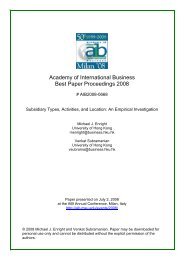AIB 2012 Conference Proceedings - Academy of International ...
AIB 2012 Conference Proceedings - Academy of International ...
AIB 2012 Conference Proceedings - Academy of International ...
You also want an ePaper? Increase the reach of your titles
YUMPU automatically turns print PDFs into web optimized ePapers that Google loves.
MONDAY<br />
How Do Foreign MNCs and Local Firms Compete An Integrative View<br />
Wei Yang, China Europe <strong>International</strong> Business School<br />
The resource-based view (RBV) and the competitive dynamics perspective are central to the strategy research.<br />
But their tight linkage and re-enforcing nature have been largely ignored. This paper integrates these two views<br />
into one theoretical framework and use survey data to test the interrelationships <strong>of</strong> the strategic resource<br />
endowment and competitive response, and their influence on firm competitive advantage. We deem that<br />
strategic resources have both direct and indirect impacts on firm competitive advantage. The indirect impact is<br />
realized through the mediating effects <strong>of</strong> competitive response speed on the relationships <strong>of</strong> strategic resources<br />
and firm competitive advantage. (For more information, please contact: Wei Yang, China Europe <strong>International</strong><br />
Business School, China: ywei@ceibs.edu)<br />
How Uncertainty Avoidance, Risk and Relatedness Matter in Emerging Economy Acquisitions<br />
Somnath Lahiri, Illinois State University<br />
Drawing on entry mode literature we examine in this study how three important factors: (a) cultural distance<br />
along the uncertainty avoidance dimension, (b) difference in country risk, and (c) relatedness between acquirer<br />
and target industry impact cross-border acquisition choice <strong>of</strong> foreign MNEs in emerging markets. Analysis <strong>of</strong> a<br />
sample <strong>of</strong> 1389 acquisitions undertaken in two emerging economies by MNEs from 33 nations over a 11-year<br />
time period generally support our hypothesized relationships on the direct and moderating influence <strong>of</strong><br />
uncertainty avoidance difference, country risk difference and relatedness on the choice <strong>of</strong> partial acquisition<br />
over full acquisition. In addition, our results suggest similar choice <strong>of</strong> acquisition when the aggregate measure<br />
<strong>of</strong> national cultural distance is used in place <strong>of</strong> uncertainty avoidance difference. We conclude by discussing<br />
various implications <strong>of</strong> the study and providing directions for future research. (For more information, please<br />
contact: Somnath Lahiri, Illinois State University, USA: slahiri@ilstu.edu)<br />
Strategic Alliances, Institutions and Performance in Emerging Markets<br />
Rand Gerges Yammine, EMLYON Business School<br />
This study tackles two research questions. First, how do institutional contexts impact the decision <strong>of</strong> foreign<br />
firms to opt for strategic alliances as entry strategies in emerging markets Second, are strategic alliances<br />
linked to superior performance in specific institutional contexts Building on institutional theory and a network<br />
perspective, we investigate the relationships between strategic alliances as entry strategies, home and host<br />
countries' institutional contexts, and performance consequences. In particular, we argue that foreign firms are<br />
more likely to enter emerging markets with strategic alliances to counteract market inefficiencies through access<br />
to valuable inter-firm networks. However when the institutional context is similar, foreign firms prefer<br />
alternative entry strategies which allow greater control namely acquisition or greenfield. We also argue that in a<br />
weak institutional context, strategic alliances are associated with superior performance in comparison with other<br />
entry strategies. We opt for a multi-industry, cross country dataset comprising 300 FDI projects in 20 emerging<br />
markets from 1995 to 2005. (For more information, please contact: Rand Gerges Yammine, EMLYON Business<br />
School, France: gergesyammine@em-lyon.com)<br />
Barriers to Bilateral Business Relations: The Case <strong>of</strong> Australia and Ukraine<br />
Genrikh Salata, Australian National University<br />
Pierre van der Eng, Australian National University<br />
Vinh Nhat Lu, Australian National University<br />
Vesna Sedoglavich, Australian National University<br />
<strong>AIB</strong> <strong>2012</strong> <strong>Conference</strong> <strong>Proceedings</strong><br />
Page 154

















